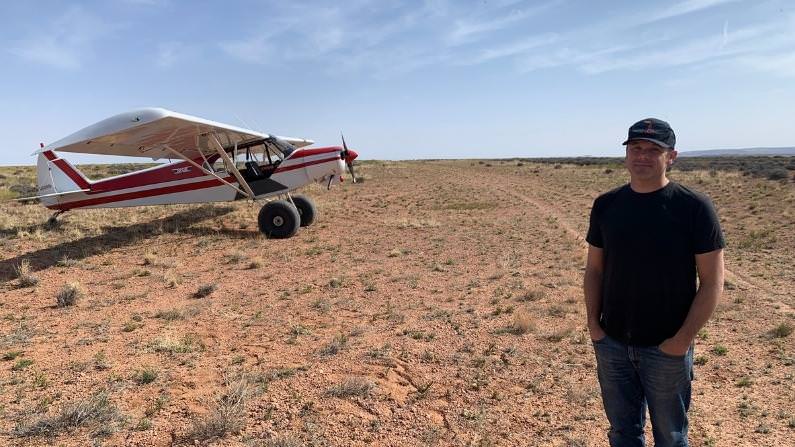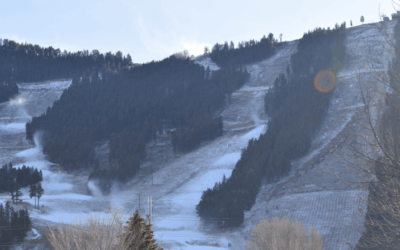This story comes to KHOL through the Rocky Mountain Community Radio coalition.
Gary Hilley’s job as a mechanic usually keeps him grounded during the week. But when he’s free, he heads up above Southeastern Utah.
Today, Hilley is in his two-seat plane called a Supercub, a lightweight craft able to take off and land with only a few hundred feet of runway. Flying over slot canyons and mesas, he heads south with Canyonlands National Park in the distance.
“So, all these orange dots are runways around us. But we’re probably going to go either to Mineral [Bottom] or Horseshoe [Canyon] right here,” Hilley said. He’s pointing to a phone screen with dozens of dots representing backcountry runways within about a 15-mile radius.
They are mostly from the region’s uranium mining days. Prospectors would use the strips to bring in supplies or labor. There are around 300 backcountry runways in Utah, mostly in the southeastern region and many in Bureau of Land Management (BLM) areas.
“This is the Mineral Bottom airstrip, which was associated with two mines,” Hilley said, looking down at a narrow dirt path on a bend in the Green River.
Hilley flies over unfazed cows, wild burros that look up curiously and a couple of antelope that seem willing to race—but no humans. That’s the point, according to Hilley. He uses his small plane to beat the crowds and explore usually hard-to-access areas of the state.
“I use way less fuel flying in there than I do driving. And I can get out there and do a hike, get back in four or five hours,” Hilley said.
He’s one of a growing number of backcountry flyers taking lightweight, fixed-wing aircraft into the wilderness.

Gary Hilley flying his Supercub backcountry plane. He spends his free time maintaining historic dirt runways in Southeastern Utah. (Justin Higginbottom/KZMU)
Roy Evans, a commercial pilot and president of the Utah Back Country Pilots Association, said the backcountry aviation industry is expanding rapidly for hobbyists.
“Those markets have been exploding for the last 10 to 20 years,” Evans said.
He said there are new options for planes and training. And although this kind of flying has been around for a long time—for Utah miners or remote Alaska residents—social media has attracted a new generation. Evans said local officials have even approached him for help in drawing flyers to their county, asking him how to add backcountry airstrips.
“And I’m like, ‘Well, there’s actually 40 already,’” Evans said.
Evans said his group has about 900 online members. They share trip reports and details on the condition of remote runaways.
“The people you’ll meet alongside these airstrips are from all over the world. We’ve met people from Germany that were out here flying around because America provides them so much more freedoms with aviation,” Evans said.
But he said not everyone is as excited about the hobby as him. Grand County commissioners submitted comments to the BLM with concerns about noise in some management areas with airstrips.
Evans said compared to other motorized vehicles—ATVs, motorcycles and especially helicopters—backcountry flying is pretty unobtrusive.
“The airplane only makes noise for those brief moments where it’s coming in to land. And then when the airplane is on the runway, we’re shut down. We push the airplane into our parking spot,” Evans said.
Kya Marienfeld with the conservation group Southern Utah Wilderness Alliance said the hobby could run up against other wilderness uses and values as it expands.
“It’s just a question the same as it is with another motorized vehicle like a Jeep or a UTV or a motorbike,” Marienfeld said. “You’re making sure that you are in the places that are the best suited for that kind of impact.”
Some historic runways in the San Rafael Swell were challenged after the area became a designated wilderness, she notes. And she said enforcement of aircraft can be hard.
“Airspace is extremely hard to regulate. Land management agencies don’t have a lot of sway or say over [Federal Aviation Administration] regulations,” Marienfeld said.
She said there are great places where this kind of flying makes sense—and likely some where it doesn’t.
“If you are a visitor or if you are wildlife out in one of these ecosystems and a plane flies overhead, it does substantially change the experience that you’re having,” she said.
Hilley, who’s been flying for five years, tries to teach pilots new to the area about the rules of the sky.
“I try and educate a lot of pilots that come to town about what’s sensitive for us. Guys love to fly the Green River like right on the water. But right now it’s full of canoes and stuff, so really not a good idea,” Hilley said.
The runways have stayed largely intact in the desert climate. Although vegetation is very slowly encroaching and the rare flood can wash away these bits of history. Hilley spends his free time maintaining the landing areas: Clearing parking and camping spots, replacing wind socks and hauling out trash that might include 50-year-old cans of beans left over from miners. At the Horseshoe Canyon runway, he’s clearing a rut with a metal rake he made himself and left here for volunteers.
He said with the privilege of being able to access these runways, there’s a responsibility to keep them safe. It’s especially needed, he thinks, as the area attracts more pilots—along with other outdoor enthusiasts heading to Southeastern Utah.
“Like we’re the mecca for mountain bikers, we’re also the mecca for backcountry flying. And that comes with pluses and minuses. With more people on the river every year there [are] more people in the air as well. And more bikers, more [side by sides], more of everything,” Hilley said.
Today on a windless day during peak tourist season, there didn’t seem to be another plane within eye or earshot.
“If you can get everyone to kind of be respectful of each other and consider their point of view. You know, they’re here to have fun. We’re here to have fun,” Hilley said.
So far, he thinks there’s enough space for everyone, whether in the sky or on the ground.






